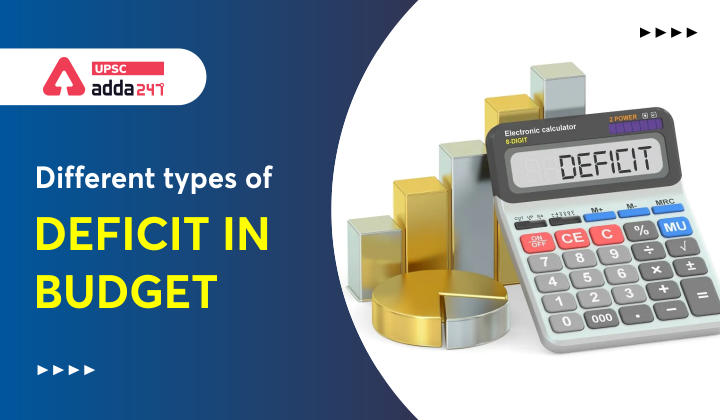Table of Contents
Relevance
- GS 3: Indian Economy and issues relating to planning, mobilization, of resources, growth, development and employment.
Budget deficit types
- There can be different types of the deficit in a budget depending upon the types of receipts and expenditure. In this article we will discuss the different types of Budget deficits that we come across whenever we read about Indian budget. All these deficits are very important for UPSC CSE or for any other competitive exams that asks questions from Indian economy.
Budgetary deficit
- Budgetary deficit is the difference between all receipts and expenses in both revenue and capital account of the government.
- If revenue expenses of the government exceed revenue receipts, it results in revenue account deficit.
- Similarly, if the capital disbursements of the government exceed capital receipts, it leads to capital account deficit.
- Budgetary deficit is usually expressed as a percentage of GDP.
Fiscal deficit
- Fiscal Deficit is the difference between the total income of the government (total taxes and non-debt capital receipts) and its total expenditure.
- The government describes fiscal deficit of India as “the excess of total disbursements from the Consolidated Fund of India, excluding repayment of the debt, over total receipts into the Fund (excluding the debt receipts) during a financial year.
Primary deficit
- Primary deficit is the difference between the fiscal deficit of the current year and the interest paid by the government on loans obtained in the past.
- It indicates that the government’s borrowings are utilised to pay the interest on loans rather than on capital expenditure.
Revenue deficit
- Revenue deficit represents that the government’s own earnings are not sufficient to meet the day-to-day operations of its administration.
- Revenue deficit turns into borrowings when the government spends more than what it earns and has to depend on the external borrowings.
- It arises when the government’s revenue expenditure exceeds the total revenue receipts.
- Revenue deficit includes those transactions that have a direct bearing on a government’s current income and expenditure.
Effective revenue deficit
- Effective Revenue Deficit is the difference between revenue deficit and grants for creation of capital assets.
- It was suggested by the Rangarajan Committee on Public Expenditure and was introduced in the Union Budget 2011-12.
- According to the Finance Ministry, revenue expenditures that result in the creation of durable assets contribute to the growth in the economy and therefore, should not be treated as unproductive in nature.
Deficit Formulae
| Budgetary deficit formula
|
Budgetary deficit = Total expenditure – Total receipts |
| Fiscal deficit formula | Fiscal deficit = Total expenditure – Total receipts excluding borrowings. |
| Primary deficit formula | Primary deficit = Fiscal Deficit-Interest payments. |
| Revenue deficit formula | Revenue deficit = Total revenue expenditure – Total revenue receipts. |
| Effective revenue deficit formula | Effective Revenue Deficit= Revenue Deficit – Grants in aid for the creation of capital assets. |
Also Read:
| AFSPA Explained: Know everything about the Act | Underutilized POSHAN Outlays | Online Gaming in India 2021: Rajya Sabha Flags Concerns | Digitalisation of Agricultural Sector: Steps by Government |
| Smart Cities Mission Extended | 15th Finance Commission | State Finances: A Study of Budgets of 2021-22 | Large Hadron Collider: Ghost Particles Detected in LHC for the First Time |
| The History of Backward Classes Commission And the Sub-Categorisation of OBCs | Elderly Population Of India: Expert Committee On Longevity Finance | Impact of US Inflation in India | Pradhan Mantri Awas Yojana- Gramin |





 TSPSC Group 1 Question Paper 2024, Downl...
TSPSC Group 1 Question Paper 2024, Downl...
 TSPSC Group 1 Answer key 2024 Out, Downl...
TSPSC Group 1 Answer key 2024 Out, Downl...
 UPSC Prelims 2024 Question Paper, Downlo...
UPSC Prelims 2024 Question Paper, Downlo...
